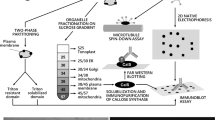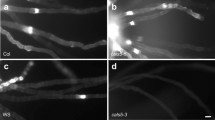Summary
Actin microfilaments form a dense network within pollen tubes of the gymnosperm Norway spruce (Picea abies). Microfilaments emanate from within the pollen grain and form long, branching arrays passing through the aperture and down the length of the pollen tube to the tip. Pollen tubes are densely packed with large amyloplasts, which are surrounded by branching microfilament bundles. The vegetative nucleus is suspended within the elongating pollen tube within a complex array of microfilaments oriented both parallel to and perpendicular with the growing axis. Microfilament bundles branch out along the nuclear surface, and some filaments terminate on or emanate from the surface. Microfilaments in the pollen tube tip form a 6 μm thick, dense, uniform layer beneath the plasma membrane. This layer ensheathes an actin depleted core which contains cytoplasm and organelles, including small amyloplasts, and extends back 36 μm from the tip. Behind the core region, the distinct actin layer is absent as microfilaments are present throughout the pollen tube. Organelle zonation is not always maintained in these conifer pollen tubes. Large amyloplasts will fill the pollen tube up to the growing tip, while the distinct layer of microfilaments and cytoplasm beneath the plasma membrane is maintained. The distinctive microfilament arrangement in the pollen tube tips of this conifer is similar to that seen in tip growth in fungi, ferns and mosses, but has not been reported previously in seed plants.
Similar content being viewed by others
References
Baskin TI, Busby CH, Fowke LC, Sammut M, Gubler F (1992) Improvements in immunostaining samples embedded in methacrylate: localization of microtubules and other antigens throughout developing organs in plants of diverse taxa. Planta 187: 405–413
Christiansen H (1972) On the development of pollen and the fertilization mechanism ofPicea abies (L.) Karst. Silvae Genet 21: 51–61
Dawkins MD, Owens JN (1993) In vitro and in vivo pollen hydration, germination, and pollen tube growth in white spruce,Picea glauca (Moench) Voss. Int J Plant Sci 154: 506–521
Derksen J, Rutten T, Lichtscheidl IK, De Win AHN, Pierson ES, Rongen G (1995a) Quantitative analysis of the distribution of organelles in tobacco pollen tubes: implications for exocytosis and endocytosis. Protoplasma 188: 267–276
— —, Van Amstel T, De Win A, Doris F, Steer M (1995b) Regulation of pollen tube growth. Acta Bot Neerl 44: 93–119
De Win AHN, Knuiman B, Pierson ES, Geurts H, Kengen HMP, Derksen J (1996) Development and cellular organization ofPinus sylvestris pollen tubes. Sex Plant Reprod 9: 93–101
Franke WW, Herth W, Van Der Woude J, Morré DJ (1972) Tubular and filamentous structures in pollen tubes: possible involvement as guide elements in protoplasmic streaming and vectorial migration of secretory vesicles. Planta 105: 317–341
Frankis RC, Grayson GK (1990) Heat-shock response in germinating pine pollen. Sex Plant Reprod 3: 195–199
He Y, Wetzstein HY (1995) Fixation induces differential tip morphology and immunolocalization of the cytoskeleton in pollen tubes. Physiol Plant 93: 757–763
Heath IB (1987) Preservation of a labile cortical array of actin filaments in growing hyphal tips of the fungusSaprolegnia ferax. Eur J Cell Biol 44: 10–16
— (1994) The cytoskeleton in hyphal growth, organelle movements, and mitosis. In: Wessels JGH, Meinhardt F (eds) The mycota 1: growth, differentiation and sexuality. Springer, Berlin Heidelberg New York Tokyo, pp 43–65
Heslop-Harrison J, Heslop-Harrison Y (1989a) Cytochalasin effects on structure and movement in the pollen tube ofIris. Sex Plant Reprod 2: 27–37
— — (1989b) Myosin associated with the surfaces of organelles, vegetative nuclei and generative cells in angiosperm pollen grains and tubes. J Cell Sci 94: 319–325
— — (1991) The actin cytoskeleton in unfixed pollen tubes following microwave accelerated DMSO permeabilization and TRITC-phalloidin staining. Sex Plant Reprod 4: 6–11
— —, Cresti M, Tiezzi A, Moscatelli A (1988) Cytoskeletal elements, cell shaping, and movement of the angiosperm pollen tube. J Cell Sci 91: 49–60
— — —, Ciampolini F (1991) Ultrastructural features of pollen tubes ofEndymion non-scriptus modified by cytochalasin D. Sex Plant Reprod 4: 73–80
Jackson SL, Heath IB (1993a) The dynamic behavior of cytoplasmic F-actin in growing hyphae. Protoplasma 173: 23–34
— — (1993b) UV microirradiation implicates F-actin in reinforcing growing hyphal tips. Protoplasma 175: 67–74
Kadota A, Wada M (1992) Reorganization of the cortical cytoskeleton in tip growing fern protonemal cells during phytochrome mediated phototropism and blue light induced apical swelling. Protoplasma 166: 35–41
Kadota A, Wada M (1995) Cytoskeletal aspects of nuclear migration during tip growth in the fernAdiantum protonemal cell. Protoplasma 188: 170–179
Lancelle SA, Hepler PK (1988) Cytochalasin induced ultrastructural alterations inNicotiana pollen tubes. Protoplasma Suppl 2: 65–75
Meske V, Hartmann E (1995) Reorganization of microfilaments in protonemal tip cells of the mossCeratodon purpureus during the phototropic response. Protoplasma 188: 59–69
Miller DD, Scordilis SP, Hepler PK (1995) Identification and localization of three classes of myosins in pollen tubes ofLilium longiflorum andNicotiana alata, J Cell Sci 108: 2549–2653
Owens JN, Morris SJ (1990) Cytological basis for cytoplasmic inheritance inPseudotsuga menziesii. I. Pollen tube and archegonial development. Am J Bot 77: 433–445
Perdue TD, Parthasarathy MV (1985) In situ localization of F-actin in pollen tubes. Eur J Cell Biol 39: 13–20
Pettitt JM (1985) Pollen tube development and characteristics of the protein emission in conifers. Ann Bot 56: 379–397
Pierson ES (1988) Rhodamine-phalloidin staining of F-actin in pollen after dimethylsulphoxide permeabilization. Sex Plant Reprod 1: 83–87
—, Cresti M (1992) Cytoskeleton and cytoplasmic organization of pollen and pollen tubes. Int Rev Cytol 140: 73–125
—, Dersken J, Traas JA (1986) Organization of microfilaments and microtubules in pollen tubes grown in vitro or in vivo in various angiosperms. Eur J Cell Biol 41: 14–18
Picton J, Steer M (1981) Determination of secretory vesicle production rates by dictyosomes in pollen tubes ofTradescantia using cytochalasin D. J Cell Sci 49: 261–272
— — (1982) A model for the mechanism of tip extension in pollen tubes. J Theor Biol 98: 15–20
Seagull RW, Falconer MM, Weerdenburg CA (1987) Microfilaments: dynamic arrays in higher plant cells. J Cell Biol 104: 995–1004
Singh H (1978) Embryology of gymnosperms. Gebrüder Borntraeger, Berlin (Handbuch der Pflanzenanatomie, vol 10, part 2)
Steer MW (1990) Role of actin in tip growth. In: Heath IB (ed) Tip growth in plant and fungal cells. Academic Press, San Diego, pp 119–145
Tang X, Hepler PK, Scordilis SP (1989a) Immunochemical and immunocytochemical identification of a myosin heavy chain polypeptide inNicotiana pollen tubes. J Cell Sci 92: 569–574
—, Lancelle SA, Hepler PK (1989b) Fluorescence microscopic localization of actin in pollen tubes: comparison of actin antibody and phalloidin staining. Cell Motil Cytoskeleton 12: 216–224
Terasaka O, Niitsu T (1994) Differential roles of microtubule and actin-myosin cytoskeleton in the growth ofPinus pollen tubes. Sex Plant Reprod 7: 264–272
Tiezzi A (1991) The pollen tube cytoskeleton. Electron Microsc Rev 4: 205–219
Tirlapur UK, Cai G, Faleri C, Moscatelli A, Scali M, Del Casino C, Tiezzi A, Cresti M (1995) Confocal imaging and immunogold electron microscopy of changes in distribution of myosin during pollen hydration, germination and pollen tube growth inNicotiana tabacum L. Eur J Cell Biol 67: 209–217
Tiwari SC, Polito VS (1988) Organization of the cytoskeleton in pollen tubes ofPyrus communis: a study employing conventional and freeze-substitution electron microscopy, immunofluorescence, and rhodamine-phalloidin. Protoplasma 147: 100–112
White RG, Sack FD (1990) Actin microfilaments in presumptive statocytes of root caps and coleoptiles. Am J Bot 77: 17–26
Author information
Authors and Affiliations
Corresponding author
Rights and permissions
About this article
Cite this article
Lazzaro, M.D. The actin microfilament network within elongating pollen tubes of the gymnospermPicea abies (Norway spruce). Protoplasma 194, 186–194 (1996). https://doi.org/10.1007/BF01882026
Received:
Accepted:
Issue Date:
DOI: https://doi.org/10.1007/BF01882026




